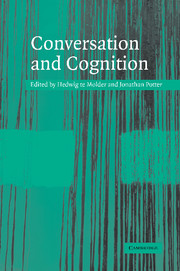Book contents
- Frontmatter
- Contents
- List of contributors
- Acknowledgements
- Transcription conventions
- 1 Talking cognition: mapping and making the terrain
- Part I The interface between cognition and action
- 2 Validating ‘observations’ in discourse studies: a methodological reason for attention to cognition
- 3 Language without mind
- 4 Using participants' video-stimulated comments to complement analyses of interactional practices
- 5 From paradigm to prototype and back again: interactive aspects of ‘cognitive processing’ in standardized survey interviews
- 6 A cognitive agnostic in conversation analysis: when do strategies affect spoken interaction?
- Part II Cognition in action
- References
- Index
5 - From paradigm to prototype and back again: interactive aspects of ‘cognitive processing’ in standardized survey interviews
Published online by Cambridge University Press: 22 September 2009
- Frontmatter
- Contents
- List of contributors
- Acknowledgements
- Transcription conventions
- 1 Talking cognition: mapping and making the terrain
- Part I The interface between cognition and action
- 2 Validating ‘observations’ in discourse studies: a methodological reason for attention to cognition
- 3 Language without mind
- 4 Using participants' video-stimulated comments to complement analyses of interactional practices
- 5 From paradigm to prototype and back again: interactive aspects of ‘cognitive processing’ in standardized survey interviews
- 6 A cognitive agnostic in conversation analysis: when do strategies affect spoken interaction?
- Part II Cognition in action
- References
- Index
Summary
Survey researchers have long been interested in the process by which answers to survey questions come about (see Schaeffer and Maynard, 2002b; Maynard and Schaeffer 2002b). The last two decades have seen considerable research on this subject. Most of this research has drawn heavily and fruitfully on social-information-processing models of the question-and-answer process, which are fundamentally psychological. These approaches commonly use one of several variants of a four-stage model of the process of responding to questions; according to the description in these models the respondent interprets the question, retrieves the requested information, evaluates the information for the purposes of reporting it, and finally maps his or her answer onto the response categories and reports an answer (see Cannell, Miller and Oksenberg, 1981; Sudman, Bradburn and Schwarz, 1996; Tourangeau, Rasinski and Rips, 2000). Such models present ‘cognitive processing’ as a psychological process that takes place within the respondent. Research based on this model has also contributed to the development of methods – such as cognitive interviewing – for improving the design of survey questions that are rooted in this psychological perspective and model. For example, the cognitive interviewing techniques of paraphrasing and ‘think-alouds’ that are used to study comprehension and information retrieval draw on psychological models to seek evidence of the cognitive processing that respondents perform, which would otherwise remain invisible (for examples, see Presser et al., 2004; Schwarz and Sudman, 1996).
- Type
- Chapter
- Information
- Conversation and Cognition , pp. 114 - 133Publisher: Cambridge University PressPrint publication year: 2005
- 10
- Cited by



